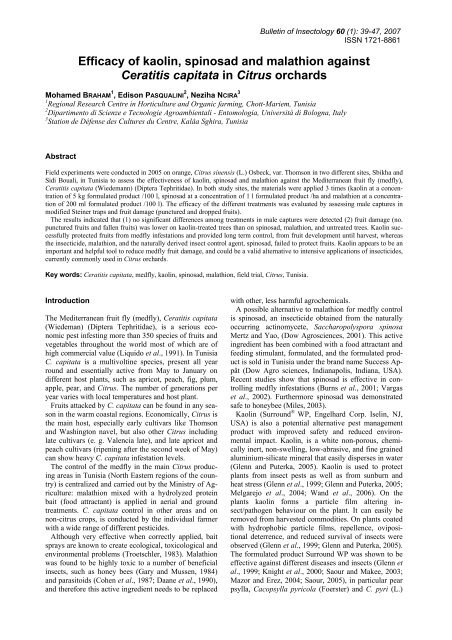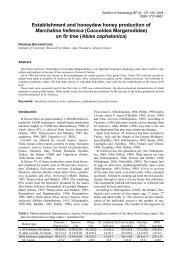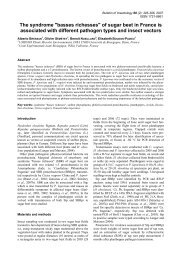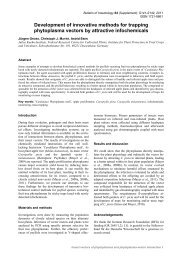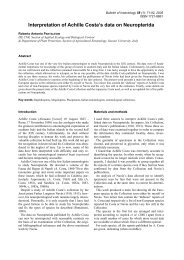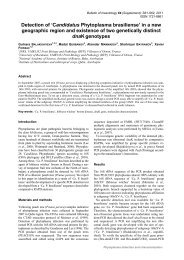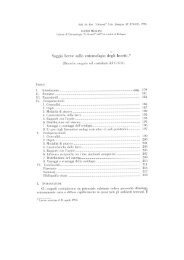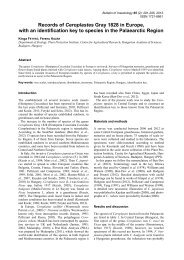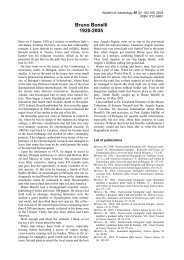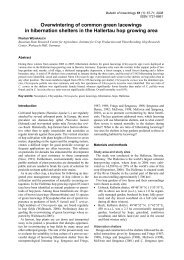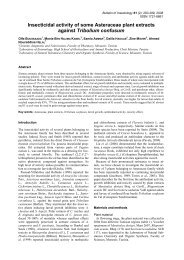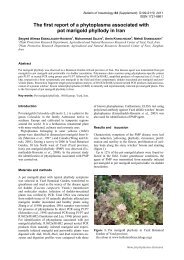Efficacy of kaolin, spinosad and malathion against Ceratitis capitata ...
Efficacy of kaolin, spinosad and malathion against Ceratitis capitata ...
Efficacy of kaolin, spinosad and malathion against Ceratitis capitata ...
Create successful ePaper yourself
Turn your PDF publications into a flip-book with our unique Google optimized e-Paper software.
Bulletin <strong>of</strong> Insectology 60 (1): 39-47, 2007<br />
ISSN 1721-8861<br />
<strong>Efficacy</strong> <strong>of</strong> <strong>kaolin</strong>, <strong>spinosad</strong> <strong>and</strong> <strong>malathion</strong> <strong>against</strong><br />
<strong>Ceratitis</strong> <strong>capitata</strong> in Citrus orchards<br />
Mohamed BRAHAM 1 , Edison PASQUALINI 2 , Neziha NCIRA 3<br />
1 Regional Research Centre in Horticulture <strong>and</strong> Organic farming, Chott-Mariem, Tunisia<br />
2 Dipartimento di Scienze e Tecnologie Agroambientali - Entomologia, Università di Bologna, Italy<br />
3 Station de Défense des Cultures du Centre, Kalâa Sghira, Tunisia<br />
Abstract<br />
Field experiments were conducted in 2005 on orange, Citrus sinensis (L.) Osbeck, var. Thomson in two different sites, Sbikha <strong>and</strong><br />
Sidi Bouali, in Tunisia to assess the effectiveness <strong>of</strong> <strong>kaolin</strong>, <strong>spinosad</strong> <strong>and</strong> <strong>malathion</strong> <strong>against</strong> the Mediterranean fruit fly (medfly),<br />
<strong>Ceratitis</strong> <strong>capitata</strong> (Wiedemann) (Diptera Tephritidae). In both study sites, the materials were applied 3 times (<strong>kaolin</strong> at a concentration<br />
<strong>of</strong> 5 kg formulated product /100 l, <strong>spinosad</strong> at a concentration <strong>of</strong> 1 l formulated product /ha <strong>and</strong> <strong>malathion</strong> at a concentration<br />
<strong>of</strong> 200 ml formulated product /100 l). The efficacy <strong>of</strong> the different treatments was evaluated by assessing male captures in<br />
modified Steiner traps <strong>and</strong> fruit damage (punctured <strong>and</strong> dropped fruits).<br />
The results indicated that (1) no significant differences among treatments in male captures were detected (2) fruit damage (no.<br />
punctured fruits <strong>and</strong> fallen fruits) was lower on <strong>kaolin</strong>-treated trees than on <strong>spinosad</strong>, <strong>malathion</strong>, <strong>and</strong> untreated trees. Kaolin successfully<br />
protected fruits from medfly infestations <strong>and</strong> provided long term control, from fruit development until harvest, whereas<br />
the insecticide, <strong>malathion</strong>, <strong>and</strong> the naturally derived insect control agent, <strong>spinosad</strong>, failed to protect fruits. Kaolin appears to be an<br />
important <strong>and</strong> helpful tool to reduce medfly fruit damage, <strong>and</strong> could be a valid alternative to intensive applications <strong>of</strong> insecticides,<br />
currently commonly used in Citrus orchards.<br />
Key words: <strong>Ceratitis</strong> <strong>capitata</strong>, medfly, <strong>kaolin</strong>, <strong>spinosad</strong>, <strong>malathion</strong>, field trial, Citrus, Tunisia.<br />
Introduction<br />
The Mediterranean fruit fly (medfly), <strong>Ceratitis</strong> <strong>capitata</strong><br />
(Wiedeman) (Diptera Tephritidae), is a serious economic<br />
pest infesting more than 350 species <strong>of</strong> fruits <strong>and</strong><br />
vegetables throughout the world most <strong>of</strong> which are <strong>of</strong><br />
high commercial value (Liquido et al., 1991). In Tunisia<br />
C. <strong>capitata</strong> is a multivoltine species, present all year<br />
round <strong>and</strong> essentially active from May to January on<br />
different host plants, such as apricot, peach, fig, plum,<br />
apple, pear, <strong>and</strong> Citrus. The number <strong>of</strong> generations per<br />
year varies with local temperatures <strong>and</strong> host plant.<br />
Fruits attacked by C. <strong>capitata</strong> can be found in any season<br />
in the warm coastal regions. Economically, Citrus is<br />
the main host, especially early cultivars like Thomson<br />
<strong>and</strong> Washington navel, but also other Citrus including<br />
late cultivars (e. g. Valencia late), <strong>and</strong> late apricot <strong>and</strong><br />
peach cultivars (ripening after the second week <strong>of</strong> May)<br />
can show heavy C. <strong>capitata</strong> infestation levels.<br />
The control <strong>of</strong> the medfly in the main Citrus producing<br />
areas in Tunisia (North Eastern regions <strong>of</strong> the country)<br />
is centralized <strong>and</strong> carried out by the Ministry <strong>of</strong> Agriculture:<br />
<strong>malathion</strong> mixed with a hydrolyzed protein<br />
bait (food attractant) is applied in aerial <strong>and</strong> ground<br />
treatments. C. <strong>capitata</strong> control in other areas <strong>and</strong> on<br />
non-citrus crops, is conducted by the individual farmer<br />
with a wide range <strong>of</strong> different pesticides.<br />
Although very effective when correctly applied, bait<br />
sprays are known to create ecological, toxicological <strong>and</strong><br />
environmental problems (Troetschler, 1983). Malathion<br />
was found to be highly toxic to a number <strong>of</strong> beneficial<br />
insects, such as honey bees (Gary <strong>and</strong> Mussen, 1984)<br />
<strong>and</strong> parasitoids (Cohen et al., 1987; Daane et al., 1990),<br />
<strong>and</strong> therefore this active ingredient needs to be replaced<br />
with other, less harmful agrochemicals.<br />
A possible alternative to <strong>malathion</strong> for medfly control<br />
is <strong>spinosad</strong>, an insecticide obtained from the naturally<br />
occurring actinomycete, Saccharopolyspora spinosa<br />
Mertz <strong>and</strong> Yao, (Dow Agrosciences, 2001). This active<br />
ingredient has been combined with a food attractant <strong>and</strong><br />
feeding stimulant, formulated, <strong>and</strong> the formulated product<br />
is sold in Tunisia under the br<strong>and</strong> name Success Appât<br />
(Dow Agro sciences, Indianapolis, Indiana, USA).<br />
Recent studies show that <strong>spinosad</strong> is effective in controlling<br />
medfly infestations (Burns et al., 2001; Vargas<br />
et al., 2002). Furthermore <strong>spinosad</strong> was demonstrated<br />
safe to honeybee (Miles, 2003).<br />
Kaolin (Surround ® WP, Engelhard Corp. Iselin, NJ,<br />
USA) is also a potential alternative pest management<br />
product with improved safety <strong>and</strong> reduced environmental<br />
impact. Kaolin, is a white non-porous, chemically<br />
inert, non-swelling, low-abrasive, <strong>and</strong> fine grained<br />
aluminium-silicate mineral that easily disperses in water<br />
(Glenn <strong>and</strong> Puterka, 2005). Kaolin is used to protect<br />
plants from insect pests as well as from sunburn <strong>and</strong><br />
heat stress (Glenn et al., 1999; Glenn <strong>and</strong> Puterka, 2005;<br />
Melgarejo et al., 2004; W<strong>and</strong> et al., 2006). On the<br />
plants <strong>kaolin</strong> forms a particle film altering insect/pathogen<br />
behaviour on the plant. It can easily be<br />
removed from harvested commodities. On plants coated<br />
with hydrophobic particle films, repellence, ovipositional<br />
deterrence, <strong>and</strong> reduced survival <strong>of</strong> insects were<br />
observed (Glenn et al., 1999; Glenn <strong>and</strong> Puterka, 2005).<br />
The formulated product Surround WP was shown to be<br />
effective <strong>against</strong> different diseases <strong>and</strong> insects (Glenn et<br />
al., 1999; Knight et al., 2000; Saour <strong>and</strong> Makee, 2003;<br />
Mazor <strong>and</strong> Erez, 2004; Saour, 2005), in particular pear<br />
psylla, Cacopsylla pyricola (Foerster) <strong>and</strong> C. pyri (L.)
(Puterka et al., 2000; Pasqualini et al., 2002), olive fruit<br />
fly, Bactrocera oleae (Gmelin) (Saour <strong>and</strong> Makee<br />
2003), pistachio psyllid, Agonoscena targionii (Lichtenstein)<br />
(Saour, 2005), <strong>and</strong> C. <strong>capitata</strong>, on nectarine, apple<br />
<strong>and</strong> persimmon (Mazor <strong>and</strong> Erez, 2004).<br />
This study aimed at evaluating the efficacy <strong>of</strong> the <strong>kaolin</strong>-based<br />
product Surround WP <strong>and</strong> <strong>of</strong> the <strong>spinosad</strong>based<br />
insecticide Success Appât <strong>against</strong> C. <strong>capitata</strong> on<br />
orange in two Tunisian study sites with different climatic<br />
conditions in comparison with the organo-phosphate insecticide<br />
<strong>malathion</strong> <strong>and</strong> an untreated control.<br />
Materials <strong>and</strong> methods<br />
Field trials were conducted in two study sites with<br />
Mediterranean climate, the mainl<strong>and</strong> site Sbikha (at approximately<br />
60 km from the sea, 35.40° N, 10.06° E, 60<br />
m above sea level) <strong>and</strong> the coastal site Sidi Bouali (at<br />
approximately 5 km from the sea, 35.55° N, 10.33° E ,<br />
15 m above sea level).<br />
Sbikha orchard<br />
The Sbikha study orchard was located on a farm <strong>of</strong> 20<br />
ha in size, at approximately 30 km from the town Kairouan<br />
in the centre <strong>of</strong> Tunisia.<br />
The trial orchard (size: approximately 0.5 ha) cultivated<br />
with Citrus, C. sinensis (L.) Osbeck, var. Thomson,<br />
consisted <strong>of</strong> 19 rows with 23 trees per row (distance<br />
between rows: 4 m; distance between trees along<br />
row: 3 m; plant age: 28 years). The plot was surrounded<br />
to the north by a row <strong>of</strong> cypress trees bordering a local<br />
road, to the east by a pear <strong>and</strong> fig orchard, to the west<br />
by a pomegranate orchard, <strong>and</strong> to the south by a Citrus<br />
orchard (Clementine, Valencia late, <strong>and</strong> Orange).<br />
To evaluate the efficacy <strong>of</strong> the different treatments, a<br />
r<strong>and</strong>omized block design with 4 replicates <strong>of</strong> 4 trees per<br />
treatment was used. Blocks <strong>and</strong> plots were arranged in<br />
one area <strong>of</strong> the study orchard along 8 adjacent rows using<br />
8 trees per row. The following treatments were<br />
compared: 1. Kaolin (formulated product -f.p-. Surround<br />
WP; concentration a.i. 95%; applied rate: 5 kg<br />
f.p. /100 l); 2. <strong>spinosad</strong> (f.p. Success Appât; concentration<br />
a.i. 24%; applied rate: 1 l f.p. /ha; 3. <strong>malathion</strong> (f.p.<br />
Fyfanon 50 EC from Cheminova Agro A/S, Denmark;<br />
concentration a.i.: 50%; applied rate: 200 ml f.p. /l00 l);<br />
4. untreated control. The first treatment was applied on<br />
September 28, 2005; at that date the mean weekly male<br />
captures in the traps were 49 (see below), <strong>and</strong> fruits<br />
were still developing. Two additional applications were<br />
carried out on October 19, <strong>and</strong> November 10, 2005.<br />
Products were applied with a manually operated knapsack<br />
sprayer with 16 l <strong>of</strong> capacity (Model H-103 Himatic<br />
Agro, India) calibrated to deliver 2.0 l <strong>of</strong> liquid<br />
suspension per tree.<br />
The remaining area <strong>of</strong> the study orchard was treated<br />
with the grower’s st<strong>and</strong>ard control strategy (applications<br />
<strong>of</strong> <strong>malathion</strong> on September 3, 19, 29, October 15, 30,<br />
<strong>and</strong> on November 10 <strong>and</strong> 24, 2005).<br />
Temperature data were collected from a meteorological<br />
station located at about 26 kilometres from the study<br />
orchard.<br />
40<br />
C. <strong>capitata</strong> flight activity<br />
To monitor the flight activity <strong>of</strong> C. <strong>capitata</strong> males,<br />
after the first treatment (September 28), 16 modified<br />
Steiner traps (Steiner, 1952), produced locally <strong>and</strong> each<br />
containing a cotton wick (3.5 cm in length by 1 cm in<br />
diameter) baited with a 2-3 ml solution <strong>of</strong> trimedlure<br />
(90%) <strong>and</strong> <strong>malathion</strong> (10%) (v:v) <strong>and</strong> refilled every four<br />
to five weeks, were used: in each plot, one trap was<br />
hung on the first <strong>of</strong> the four trees (4 monitoring traps<br />
per treatment) at a height <strong>of</strong> 1.2 - 1.5 m. The distance<br />
between traps varied from 6 m along blocks to 8 m between<br />
blocks. The number <strong>of</strong> males captured per trap<br />
was recorded weekly.<br />
Fruit damage<br />
Due to the relatively low number <strong>of</strong> fruit per tree, we<br />
decided to inspect all 4 trees <strong>of</strong> each plot for fruit damage.<br />
To avoid biasing <strong>of</strong> data due to old fruit damage,<br />
prior to applying the first treatment, all trees were surveyed<br />
for damaged fruits, <strong>and</strong> attacked fruits (punctured<br />
<strong>and</strong> dropped fruits) were removed. Additional assessments<br />
for damaged fruits were conducted once a week<br />
throughout the study period. Punctured fruits were recorded<br />
<strong>and</strong> marked, <strong>and</strong> dropped fruits were recorded<br />
<strong>and</strong> removed. At the end <strong>of</strong> the study period, the total<br />
number <strong>of</strong> punctured <strong>and</strong> dropped fruits per tree was<br />
calculated.<br />
Sidi Bouali orchard<br />
The Sidi Bouali study orchard was located on a farm<br />
<strong>of</strong> approximately 6 ha in size, cultivated mostly with<br />
different Citrus <strong>and</strong> pomegranate cultivars. The study<br />
orchard was surrounded to the north by prickly pear, to<br />
the east by pomegranate, to the south by orange (C. sinensis<br />
(L.) Osbeck) var. Maltaise <strong>and</strong> Clementine (C.<br />
clementina Hort. ex Tanaka), <strong>and</strong> to the west by different<br />
Citrus fruits (orange var. Valencia late, lemon, <strong>and</strong><br />
sweet orange).<br />
The study orchard was approximately 0.5 ha in size,<br />
<strong>and</strong> consisted <strong>of</strong> 15 rows <strong>of</strong> 24-year-old Citrus trees, C.<br />
sinensis (L.) Osbeck var. Thomson, with 8 trees per<br />
row. The study orchard was divided into 4 plots, different<br />
in size: one plot <strong>of</strong> two rows was sprayed with <strong>kaolin</strong><br />
(f.p. Surround WP; applied rate: same as above), an<br />
adjacent additional plot <strong>of</strong> two rows was treated with<br />
<strong>spinosad</strong> (f.p. Success Appât; applied rate: same as<br />
above), one plot <strong>of</strong> 10.5 rows was treated with<br />
<strong>malathion</strong> (f.p. Fyfanon 50 EC; applied rate: same as<br />
above), while 4 trees <strong>of</strong> the last row were used as untreated<br />
control plot.<br />
Treatments (<strong>kaolin</strong>, <strong>spinosad</strong>, <strong>and</strong> <strong>malathion</strong>) were<br />
applied for the first time on October 14, when the average<br />
weekly number <strong>of</strong> males captured per trap was<br />
180.5, <strong>and</strong> repeated on October 29, <strong>and</strong> November 17.<br />
Due to the high infestation level, two additional sprays<br />
were applied to the <strong>spinosad</strong>- <strong>and</strong> the <strong>malathion</strong>-treated<br />
plot on November 8 <strong>and</strong> 21. All sprays were applied<br />
with the same knapsack sprayer used in Sbikha, but the<br />
sprayer was calibrated to deliver 3 l <strong>of</strong> solution per tree.<br />
Before the beginning <strong>of</strong> the trial, the entire study orchard<br />
was treated with <strong>malathion</strong> by the grower on<br />
September 8, 22, <strong>and</strong> on October 8.
Throughout the study period, weather data were recorded<br />
by an automatic meteorological station (National<br />
Institute <strong>of</strong> Rural Engineering, Water <strong>and</strong> Forest,<br />
INGREF) situated at about 10 km from the study orchard.<br />
C. <strong>capitata</strong> flight activity<br />
To monitor C. <strong>capitata</strong> flight activity, one modified<br />
Steiner trap baited with trimedlure-<strong>malathion</strong> (for details<br />
see paragraph <strong>of</strong> Sbikha orchard) was hung on a<br />
tree in the centre <strong>of</strong> the first row <strong>of</strong> the plot, <strong>and</strong><br />
checked weekly for C. <strong>capitata</strong> male captures.<br />
Fruit damage<br />
Within each plot, one tree was selected <strong>and</strong> checked<br />
weekly for punctured fruits. The 4 selected trees bore<br />
approximately the same number <strong>of</strong> fruits. At every<br />
check, new punctured fruits were marked with indelible<br />
ink; dropped fruits were recorded, collected, <strong>and</strong> removed.<br />
In order to assess fruit damage during ripening,<br />
at the end <strong>of</strong> the study period, the total number <strong>of</strong><br />
punctured <strong>and</strong> dropped fruits per tree was determined.<br />
To assess for fruit damage at harvest, on December 1,<br />
three days before harvest, 50 fruits per treatment were<br />
collected from at least 5 different trees <strong>and</strong> from the<br />
four trees in the control plot, brought to the laboratory,<br />
<strong>and</strong> examined for medfly damage (sting marks).<br />
Statistical analysis<br />
In the Sbikha orchard, the effects <strong>of</strong> blocks <strong>and</strong> treatments<br />
on the total male captures <strong>and</strong> fruit damage were<br />
analyzed using a two-way ANOVA: blocks <strong>and</strong> treatments<br />
were used as independent variables <strong>and</strong> “total<br />
number <strong>of</strong> male capture”, “total number <strong>of</strong> punctured<br />
fruits”, <strong>and</strong> “total number <strong>of</strong> dropped fruits” as dependent<br />
variables. All analyses were done using Minitab<br />
13.1 S<strong>of</strong>tware (Minitab. Inc., PA, USA).<br />
In the Sidi Bouali orchard, since only one large plot<br />
Males captured/trap<br />
350<br />
300<br />
250<br />
200<br />
150<br />
100<br />
50<br />
0<br />
<br />
<br />
<br />
<br />
<br />
<br />
<br />
<br />
<br />
<br />
<br />
<br />
<br />
per treatment was used <strong>and</strong> plots were different in size,<br />
the total number <strong>of</strong> male captures <strong>and</strong> fruits damage<br />
during development (number <strong>of</strong> punctured <strong>and</strong> dropped<br />
fruits) were reported but were not statistically analyzed.<br />
Results<br />
Sbikha orchard<br />
C. <strong>capitata</strong> flight activity<br />
The flight activity <strong>of</strong> C. <strong>capitata</strong> males was low in<br />
early October, increased after October 19, peaking at<br />
November 16, <strong>and</strong> remained relatively stable after November<br />
23 till the end <strong>of</strong> the experiment. In all treatments,<br />
the trap captures were highest during the week<br />
from 10 to 16 November, period when fruits were ripening<br />
(figure 1). The combination blocks /treatments<br />
show no significant difference in males captures between<br />
blocks nor between treatments (two way<br />
ANOVA: Blocks, F3,15 = 2.4, P = 0.135. Treatments,<br />
F3,15 = 1.27, P = 3.341). However, weekly male captures<br />
trap were lowest in the <strong>kaolin</strong>-treated plots, intermediate<br />
in the <strong>malathion</strong>- <strong>and</strong> <strong>spinosad</strong>-treated plots, <strong>and</strong> highest<br />
in the untreated control plots (figure 1).<br />
Fruit damage<br />
Differences among blocks in both the total number <strong>of</strong><br />
punctured <strong>and</strong> dropped fruits were not significant (twoway<br />
ANOVA: F3,15 = 0.74, P = 0.555 for punctured<br />
fruits; F3,15 = 2.02, P = 0.182 for dropped fruits), showing<br />
that the C. <strong>capitata</strong> population was distributed uniformly<br />
within the study area. Differences among treatments<br />
in the total number <strong>of</strong> punctured <strong>and</strong> dropped<br />
fruits, instead, were significant (Two-way ANOVA:<br />
F3,15 = 4.13, P = 0.043 for punctured fruits; F3,15 = 5.54,<br />
P = 0.020 for dropped fruits). The average numbers <strong>of</strong><br />
punctured <strong>and</strong> dropped fruits over the study period are<br />
given by figures 2 <strong>and</strong> 3.<br />
<br />
<br />
<br />
<br />
<br />
<br />
<br />
<br />
<br />
<br />
<br />
<br />
<br />
<br />
<br />
<br />
<br />
<br />
<br />
<br />
<br />
<br />
<br />
<br />
<br />
<br />
<br />
<br />
<br />
<br />
<br />
<br />
<br />
<br />
<br />
<br />
<br />
<br />
<br />
<br />
<br />
<br />
<br />
<br />
<br />
<br />
<br />
<br />
<br />
<br />
<br />
<br />
<br />
<br />
<br />
<br />
<br />
<br />
<br />
<br />
<br />
<br />
<br />
<br />
<br />
<br />
<br />
<br />
<br />
<br />
<br />
<br />
<br />
<br />
<br />
<br />
<br />
Oct, 8 Oct, 12 Oct, 19 Oct, 26 Nov, 10 Nov, 16 Nov, 23 Nov, 30 Dec, 6<br />
<br />
<br />
Kaolin<br />
Dates<br />
<br />
<br />
Spinosad<br />
<br />
<br />
Malathion<br />
<br />
<br />
Control<br />
Figure1. Mean number <strong>of</strong> C. <strong>capitata</strong> males captured weekly per trap in the modified Steiner traps baited with<br />
trimedlure-<strong>malathion</strong> in the Sbikha orchard (four traps per treatment).<br />
41
42<br />
Mean number/tree<br />
8<br />
7<br />
6<br />
5<br />
4<br />
3<br />
2<br />
1<br />
0<br />
Oct, 8 Oct, 12 Oct, 19 Oct, 26 Nov, 10 Nov, 16 Nov, 23 Nov, 30<br />
Dates<br />
Kaolin Spinosad Malathion Control<br />
Figure 2. Mean number <strong>of</strong> punctured fruits per tree in the different treatments in the Sbikha orchard.<br />
Mean number/tree<br />
1.2<br />
1.0<br />
0.8<br />
0.6<br />
0.4<br />
0.2<br />
0<br />
Oct, 8 Oct, 12 Oct, 19 Oct, 26 Nov, 10 Nov, 16 Nov, 23 Nov, 30<br />
Dates<br />
Kaolin Spinosad Malathion Control<br />
Figure 3. Mean number <strong>of</strong> dropped fruits per tree in the different treatments in Sbikha orchard.<br />
Sidi Bouali orchard<br />
C. <strong>capitata</strong> flight activity<br />
The flight activity <strong>of</strong> C. <strong>capitata</strong> males was important<br />
during the study period peaking at the end <strong>of</strong> October –<br />
beginning <strong>of</strong> November (figure 4). The average weekly<br />
male capture recorded was 340.14 in <strong>kaolin</strong>-treated plot,<br />
457.85 in <strong>spinosad</strong>-treated plot, 429.14 in <strong>malathion</strong>treated<br />
plot <strong>and</strong> 661.85 in the untreated plot.<br />
Fruit damage<br />
Fruit damage during fruit ripening:<br />
The number <strong>of</strong> punctured fruits during ripening is<br />
given by the figure 5. For <strong>kaolin</strong> treated plot only 7<br />
fruits per tree were attacked throughout the study period<br />
specifically after November 1, (they were 2, 1, 2 <strong>and</strong> 2<br />
fruits respectively on Nov.11, Nov. 17, Nov. 24 <strong>and</strong><br />
Dec. 1, 2005). However, the total numbers <strong>of</strong> punctured<br />
fruit in the other treatments plots were high with 101,
Number <strong>of</strong> males<br />
2000<br />
1500<br />
1000<br />
500<br />
0<br />
<br />
<br />
<br />
<br />
<br />
<br />
<br />
<br />
<br />
<br />
<br />
<br />
<br />
<br />
<br />
<br />
<br />
<br />
<br />
<br />
<br />
<br />
<br />
<br />
<br />
<br />
<br />
<br />
<br />
<br />
<br />
<br />
<br />
<br />
<br />
<br />
<br />
<br />
<br />
<br />
<br />
<br />
<br />
<br />
<br />
<br />
<br />
<br />
<br />
<br />
<br />
<br />
<br />
<br />
<br />
<br />
<br />
<br />
<br />
<br />
<br />
<br />
<br />
<br />
<br />
<br />
<br />
<br />
<br />
<br />
<br />
<br />
<br />
<br />
<br />
<br />
<br />
<br />
<br />
<br />
<br />
<br />
<br />
<br />
Oct, 21 Oct, 29 Nov, 5 Nov, 11 Nov, 17 Nov, 24 Dec, 1<br />
Dates<br />
<br />
<br />
<br />
<br />
<br />
<br />
<br />
Kaolin Spinosad Malathion<br />
<br />
<br />
Control<br />
Figure 4. Number <strong>of</strong> males captured weekly in the different treatments in the modified Steiner trap baited with<br />
trimedlure-<strong>malathion</strong> in Sidi Bouali.<br />
Mean number/tree<br />
60<br />
50<br />
40<br />
30<br />
20<br />
10<br />
0<br />
Oct, 21 oct, 29 Nov, 5 Nov, 11 Nov, 17 Nov, 24 Dec, 1<br />
Dates<br />
Kaolin Spinosad Malathion Control<br />
Figure 5. Mean number <strong>of</strong> punctured fruits per tree in Sidi Bouali orchard.<br />
136, <strong>and</strong> 140 respectively for <strong>spinosad</strong>, <strong>malathion</strong> <strong>and</strong><br />
control plots.<br />
Regarding the fallen fruits the <strong>kaolin</strong> treated plot<br />
shows the lowest damage with only a total <strong>of</strong> 6 dropped<br />
fruit during the study period in comparison with 69, 56,<br />
<strong>and</strong> 98 respectively for <strong>spinosad</strong>, <strong>malathion</strong> <strong>and</strong> control<br />
plots (figure 6).<br />
Fruit damage at harvest:<br />
The results on fruit damage at harvest reflect those on<br />
fruit damage during fruit ripening: in the Sidi Bouali orchard,<br />
3 days before harvest, in the <strong>kaolin</strong>-treated plot,<br />
only 2 out <strong>of</strong> 50 r<strong>and</strong>omly selected fruits were punctured,<br />
while respectively 45, 38, <strong>and</strong> 47 fruits out <strong>of</strong> 50 showed<br />
C. <strong>capitata</strong> punctures in the plot treated with <strong>spinosad</strong>,<br />
<strong>malathion</strong> <strong>and</strong> in the untreated control plot.<br />
43
Mean number/tree<br />
44<br />
60<br />
50<br />
40<br />
30<br />
20<br />
10<br />
0<br />
Oct, 21 Oct, 29 Nov, 5 Nov, 11 Nov, 17 Nov, 24 Dec, 1<br />
Dates<br />
Kaolin Spinosad Malathion Control<br />
Figure 6. Mean number <strong>of</strong> dropped fruits per tree in Sidi Bouali orchard.<br />
Discussion<br />
This study aimed at verifying whether the organic insecticides<br />
<strong>kaolin</strong> <strong>and</strong> <strong>spinosad</strong> could be used instead <strong>of</strong> conventional<br />
agrochemicals for C. <strong>capitata</strong> control in Citrus<br />
orchards. In one trial, <strong>kaolin</strong> was more efficient than <strong>spinosad</strong><br />
<strong>and</strong> the insecticide <strong>malathion</strong>. Formulated <strong>kaolin</strong>,<br />
forming a particle film on plants, thus seems to be an<br />
important <strong>and</strong> helpful tool for the control <strong>of</strong> C. <strong>capitata</strong><br />
in Citrus groves. In Israel, Mazor <strong>and</strong> Erez (2004) conducted<br />
both laboratory <strong>and</strong> field tests with formulated<br />
<strong>kaolin</strong> (Surround WP), <strong>and</strong> obtained an almost complete<br />
protection on nectarine, apple, <strong>and</strong> persimmon <strong>against</strong><br />
infestations <strong>of</strong> the medfly. Kaolin also showed high efficacy<br />
in controlling an another Tephritid fly, the olive<br />
fruit fly, B. oleae, in olive groves in Syria (Saour <strong>and</strong><br />
Makee, 2003): fruit damage on <strong>kaolin</strong>-treated olive trees<br />
was significantly lower than on untreated control trees.<br />
Kaolin provided season-long insect control (> 14 weeks)<br />
outperforming the insecticide Dimethoate.<br />
As other species <strong>of</strong> the family Tephritidae, also adults<br />
<strong>of</strong> C. <strong>capitata</strong> are known for their flying foraging behaviour<br />
between trees <strong>and</strong> adjacent orchards (Prokopy<br />
<strong>and</strong> Roitberg, 1989). In our trials, experimental plots<br />
were side by side without buffer zone permitting free<br />
adult C. <strong>capitata</strong> movement <strong>and</strong> consequently a uniform<br />
fruit damage <strong>and</strong> relatively similar adult captures. This<br />
is true for <strong>spinosad</strong>-treated plots, <strong>malathion</strong> –treated<br />
plots <strong>and</strong> un-sprayed plots but not in <strong>kaolin</strong> treated plots<br />
where both damaged fruits <strong>and</strong> males captures were less<br />
important suggesting a relatively good protection <strong>of</strong><br />
<strong>kaolin</strong> treated trees.<br />
Many species <strong>of</strong> phytophagous arthropods use visual<br />
cues to locate their hosts (Owens <strong>and</strong> Prokopy, 1986).<br />
Tephritid fruit flies are attracted to colors <strong>and</strong> shapes<br />
reminiscent <strong>of</strong> host fruit <strong>and</strong> foliage. Katsoyannos (1989)<br />
tested seven colours in attracting C. <strong>capitata</strong> in Citrus<br />
orchards <strong>and</strong> found that the yellow colour was very attractive<br />
to fertilized females, whereas blue <strong>and</strong> white<br />
were the least attractive colours. Also Economopoulos<br />
(2002) stated that the preferred colour <strong>of</strong> C. <strong>capitata</strong> females<br />
is yellow, especially fluorescent yellow.<br />
Little research has been published on male C. <strong>capitata</strong><br />
preference for visual cue in traps baited with trimedlure<br />
probably because trimedlure is a such potent attractant<br />
(Nakagawa et al., 1971). Epsky et al., (1996) tested different<br />
colored inserts in Jackson traps baited with<br />
trimedlure <strong>and</strong> found that traps containing either yellow<br />
or orange inserts capture more C. <strong>capitata</strong> males than<br />
those with st<strong>and</strong>ard inserts.<br />
The trees, leaves <strong>and</strong> fruits treated with <strong>kaolin</strong> <strong>and</strong><br />
thus coated with a white particle film could influence<br />
the l<strong>and</strong>ing <strong>of</strong> females (Saour <strong>and</strong> Makee, 2003).<br />
In our trials, we did not find significant differences<br />
among treatments in the number <strong>of</strong> males captured in<br />
modified Steiner traps, probably due to (1) the high<br />
adult population level (figure 1, figure 4) <strong>and</strong> (2) the<br />
powerful attraction <strong>of</strong> males by the parapheromone<br />
trimedlure over relatively long distances (Cunningham,<br />
1989). Furthermore, the modified Steiner traps were<br />
yellow-orange in colour, <strong>and</strong> thus easy to locate for C.<br />
<strong>capitata</strong> adults.<br />
Saour <strong>and</strong> Makee (2003) suggested that the bright<br />
white colour <strong>of</strong> <strong>kaolin</strong>-sprayed olive trees may disrupt<br />
the orientation <strong>of</strong> the olive fruit fly, B. oleae, within the<br />
olive grove. However, the Authors did not support their<br />
hypothesis with data on female captures in MacPhail<br />
traps baited with bicarbonate solution.<br />
The use <strong>of</strong> the effective female trapping system consisting<br />
<strong>of</strong> McPhail traps baited with three synergistically<br />
acting food attractants (ammonium acetate, putrescine<br />
<strong>and</strong> trimethylamine) (Epsky et al., 1995; Heath et al.,
1997) would probably have enabled us to collect detailed<br />
data on female captures.<br />
In the Sbikha orchard, the slight decrease in the average<br />
weekly male captures with 94.88 <strong>and</strong> 85.69 recorded<br />
respectively in the plots treated with <strong>spinosad</strong><br />
<strong>and</strong> <strong>malathion</strong> compared to untreated plots (117.55)<br />
could be due to mortality <strong>of</strong> males caused by the insecticide<br />
applications. However, the number <strong>of</strong> captured<br />
males was always lowest in the <strong>kaolin</strong> treated plots<br />
(mean <strong>of</strong> 63.11 weekly males captured).<br />
Puterka et al. (2000) had successfully used formulated<br />
<strong>kaolin</strong> <strong>against</strong> the pear psylla C. pyricola, <strong>and</strong> the<br />
authors identified six mechanisms or mode <strong>of</strong> action: repellence,<br />
ovipositional deterrence, reduced feeding efficacy,<br />
impeded grasping <strong>of</strong> the host, host camouflage,<br />
<strong>and</strong> direct mortality. The efficacy <strong>of</strong> <strong>kaolin</strong> <strong>against</strong> C.<br />
<strong>capitata</strong> may be attributed to repellence, <strong>and</strong>/or ovipositional<br />
deterrence, because we found males in monitoring<br />
traps, <strong>and</strong> we observed adults flying in the canopy. Furthermore,<br />
in the <strong>kaolin</strong>-treated plots, fruits showed female<br />
punctures only on their untreated parts (usually the<br />
spray did not reach the bottom part <strong>of</strong> the fruits).<br />
In both trials, <strong>spinosad</strong> seems to show little efficacy<br />
with regard to fruit damage. The efficacy <strong>of</strong> the <strong>spinosad</strong>-based<br />
product <strong>against</strong> C. <strong>capitata</strong> was very low. Our<br />
results do therefore not confirm the positive results obtained<br />
by other researchers with <strong>spinosad</strong>, where in both<br />
field <strong>and</strong> laboratory tests <strong>spinosad</strong>-based treatments<br />
provided good control <strong>of</strong> C. <strong>capitata</strong> <strong>and</strong> Caribbean<br />
fruit fly, Anastrepha ludens (Leow) (Burns et al., 2001;<br />
King <strong>and</strong> Hennessey, 1996; Vargas et al., 2002; Mangan<br />
et al., 2006). The poor efficacy <strong>of</strong> <strong>spinosad</strong> as well<br />
as <strong>of</strong> the chemical st<strong>and</strong>ard <strong>malathion</strong> may be due to (1)<br />
the unusually high C. <strong>capitata</strong> populations present during<br />
the study period. Temperature is the most important<br />
factor affecting C. <strong>capitata</strong> life cycle (Vargas et al.,<br />
1997, Israely et al., 2004). The population build-up in<br />
Temperature °C<br />
50<br />
40<br />
30<br />
20<br />
10<br />
0<br />
Sept, 1<br />
Sept, 6<br />
our study orchards was probably due to the high temperatures<br />
that occurred during summer <strong>and</strong> autumn (figures<br />
7 <strong>and</strong> 8), permitting a rapid development <strong>of</strong> generations.<br />
(2) Also, <strong>malathion</strong> <strong>and</strong> <strong>spinosad</strong>, volatiles<br />
molecules could have lost persistence on the crop by<br />
rapid degradation owing to excessive temperatures <strong>and</strong><br />
intense sunlight, while <strong>kaolin</strong> consisting <strong>of</strong> particles remained<br />
on the trees.<br />
Dust particles are known to be disruptive for natural<br />
enemies (Debach, 1979) <strong>and</strong> resurgence <strong>of</strong> pest species<br />
populations that are regulated by natural enemies may<br />
occur in particle-film treated trees. The likelihood <strong>of</strong> reduced<br />
beneficial insect activity should not be ignored.<br />
Knight et al., (2000) described increased levels <strong>of</strong> the<br />
western tentiform leafminer Phyllonorycter elmaella Doganlar<br />
<strong>and</strong> Mutuura, as well as significantly lower parasitism<br />
<strong>of</strong> this pest on <strong>kaolin</strong> (M96-018)-treated apple<br />
trees compared with untreated trees. We did not evaluate<br />
the efficacy <strong>of</strong> natural parasitoids <strong>and</strong> predators which is<br />
generally low in Citrus orchards due to heavy insecticide<br />
applications yearly conducted <strong>against</strong> the medfly <strong>and</strong><br />
other important pests such as Phyllocnistis citrella Stainton<br />
(citrus leafminer), aphids <strong>and</strong> mealy bugs.<br />
The results <strong>of</strong> our study suggest that three applications<br />
<strong>of</strong> <strong>kaolin</strong> are sufficient for the control <strong>of</strong> C. <strong>capitata</strong> in<br />
Citrus orchards, outperforming the insecticides <strong>malathion</strong><br />
<strong>and</strong> <strong>spinosad</strong>. However, the efficacy <strong>of</strong> <strong>kaolin</strong> may be<br />
reduced when rainy conditions follow the <strong>kaolin</strong> sprays.<br />
In fact, Mazor <strong>and</strong> Erez (2004) indicated that products<br />
such as <strong>kaolin</strong> are best suited to dry regions because<br />
they may be washed <strong>of</strong>f by heavy rainfalls.<br />
In conclusion, <strong>kaolin</strong> seems to be a promising <strong>and</strong><br />
helpful tool for the control <strong>of</strong> medfly populations in Citrus<br />
orchards. However, to optimize its efficacy, further<br />
studies on the number, the concentration, <strong>and</strong> the timing<br />
<strong>of</strong> the applications (early in the season before egglaying)<br />
are needed.<br />
Sept, 11<br />
Sept, 16<br />
Sept, 21<br />
Sept, 26<br />
Oct, 1<br />
Oct, 6<br />
Oct, 11<br />
Oct, 16<br />
Oct, 21<br />
Oct, 26<br />
Oct, 31<br />
Min Max Average<br />
Nov, 5<br />
Nov, 10<br />
Nov, 15<br />
Nov, 20<br />
Nov, 25<br />
Nov, 30<br />
Figure 7. Temperature value (minimum, maximum <strong>and</strong> average) during the trial September-November 2005, in<br />
Sbikha orchard (data from meteorological station located at about 26 km from the study site).<br />
45
46<br />
Temperature °C<br />
40<br />
30<br />
20<br />
10<br />
0<br />
Sept, 1<br />
Sept, 5<br />
Sept, 9<br />
Sept, 13<br />
Sept, 17<br />
Sept, 21<br />
Sept, 25<br />
Sept, 29<br />
Oct, 3<br />
Oct, 7<br />
Oct, 11<br />
Max. Min. Average<br />
Oct, 15<br />
Oct, 19<br />
Oct, 23<br />
Oct, 27<br />
Oct, 31<br />
Nov, 4<br />
Nov, 8<br />
Nov, 12<br />
Nov, 16<br />
Nov, 20<br />
Nov, 24<br />
Nov, 28<br />
Figure 8. Temperature value (minimum, maximum <strong>and</strong> average) during the trial September-November 2005, in Sidi<br />
Bouali orchard (from meteorological station located at about 10 km).<br />
Acknowledgements<br />
We wish to thank Mr. Mbarek <strong>and</strong> Mr. Ajmi for lending<br />
their orchards for the field trial. We thank Pr<strong>of</strong>essor Ben<br />
Kheder, Director <strong>of</strong> the CTAB for providing the <strong>spinosad</strong>-based<br />
bait. Steiner traps <strong>and</strong> trimedlure were delivered<br />
by the Tunisian Ministry <strong>of</strong> Agriculture (Direction<br />
Générale de la protection et du contrôle de la qualité des<br />
produits Agricoles). Mr. Mohsen Mansur (Research<br />
centre <strong>of</strong> Chott-Mariem) is gratefully acknowledged for<br />
supplying temperature data.<br />
References<br />
BURNS R. E., HARRIS D. L., MORENO D. S., EGER J. E., 2001.-<br />
<strong>Efficacy</strong> <strong>of</strong> <strong>spinosad</strong> bait sprays to control Mediterranean <strong>and</strong><br />
Caribbean fruit flies (Diptera, Tephritidae) in commercial Citrus<br />
in Florida.- Florida Entomologist, 84 (4): 672-678.<br />
COHEN E., PODOLER H., EL-HAMALAUWI M., 1987.- Effects <strong>of</strong><br />
the <strong>malathion</strong>-bait mixture used on citrus to control <strong>Ceratitis</strong><br />
<strong>capitata</strong> (Wiedemann) on the Florida red scale Chrysomphalus<br />
aonidum (L.) <strong>and</strong> its parasitoid Aphytis holoxanthus<br />
De bach.- Bulletin <strong>of</strong> Entomological Research, 77: 303-307.<br />
CUNNINGHAM R. T., 1989.- Parapheromones, pp. 221-230. In:<br />
World Crop Pests, Volume 3A. Fruit flies their biology, natural<br />
enemies <strong>and</strong> control (ROBINSON A. S., HOOPER G., Eds.).- Elsevier<br />
Science Publishers B.V., Amsterdam, The Netherl<strong>and</strong>s.<br />
DAANE K. M., DAHLSEN D. L., DREISTADT S. H., 1990.- Effects<br />
<strong>of</strong> Mediterranean fruit fly <strong>malathion</strong> bait spray on the<br />
longevity <strong>and</strong> oviposition <strong>of</strong> parasitoids <strong>of</strong> linden <strong>and</strong> tulip<br />
tree aphids (Homoptera : Aphididae).- Environmental Entomology,<br />
19: 1130-1134.<br />
DEBACH P, 1979.- Biological control <strong>of</strong> natural enemies.-<br />
Cambridge University Press, New York, USA.<br />
DOW AGROSCIENCES, 2001.- Spinosad Technical bulletin.-<br />
Dow AgroSciences LLC, Indianapolis, Indiana, USA.<br />
ECONOMOPOULOS A. P., 2002.- Mediterranean fruit fly: attraction/trapping<br />
for detection, monitoring <strong>and</strong> control.- Phytoparasitica,<br />
30 (2): 115-117.<br />
EPSKY N. D., HEATH R. R., GUZMAN A., MEYER W. L., 1995.-<br />
Visual cue <strong>and</strong> chemical cue interactions in a dry trap with<br />
food-based synthetic attractant for <strong>Ceratitis</strong> <strong>capitata</strong> <strong>and</strong><br />
Anastrepha ludens (Diptera : Tephritidae).- Environmental<br />
Entomology, 24: 1387-1395.<br />
EPSKY N. D., HEATH R. R., UCHIDA G., GUZMAN A., RIZZO J.,<br />
VARGAS R., JERONIMO F., 1996.- Capture <strong>of</strong> Mediterranean<br />
fruit flies (Diptera : Tephritidae) using color inserts in<br />
Trimedlure-baited Jackson traps.- Environmental Entomology,<br />
25 (2): 256-260.<br />
GARY N. E., MUSSEN E. C., 1984.- Impact <strong>of</strong> Mediterranean<br />
fruit fly <strong>malathion</strong> bait spray on honeybees.- Environmental<br />
Entomology, 13: 711-717.<br />
GLENN D. M, PUTERKA G. J., 2005.- Particle films: A new<br />
technology for agriculture.- Horticultural Reviews, 31: 1-44.<br />
GLENN D. M., PUTERKA G. J., VANDERZWET T., BYERS R. E.,<br />
FELDHAKE C., 1999.- Hydrophobic particle films: a new<br />
paradigm for suppression <strong>of</strong> arthropod pests <strong>and</strong> plant diseases.-<br />
Journal <strong>of</strong> Economic Entomology, 92: 759-771.<br />
HEATH R. R., EPSKY N. D., DUEBEN B. D., RIZZO J., JERONIMO<br />
F., 1997.- Adding methyl-substituted ammonia derivatives<br />
to a food-based synthetic attractant on capture <strong>of</strong> the Mediterranean<br />
<strong>and</strong> Mexican fruit flies (Diptera: Tephritidae).-<br />
Journal <strong>of</strong> Economic Entomology, 90 :1584-1589.<br />
ISRAELY N., RITTE U., OMAN S. D., 2004.- Inability <strong>of</strong> <strong>Ceratitis</strong><br />
<strong>capitata</strong> (Diptera : Tephritidae) to overwinter in the<br />
Judean hills.- Journal <strong>of</strong> Economic Entomology, 97 (1): 33-<br />
42.<br />
KATSOYANNOS B. I., 1989.- Response to shape, size <strong>and</strong> color.<br />
pp: 307-324. In: World Crop Pests, Volume 3A. Fruit flies<br />
their biology, natural enemies <strong>and</strong> control (ROBINSON A. S.,<br />
HOOPER G., Eds.).- Elsevier Science Publishers B.V., Amsterdam,<br />
The Netherl<strong>and</strong>s.<br />
KING J. R., HENNESSEY M. K., 1996.- Spinosad bait for the<br />
Caribbean fruit fly (Diptera, Tephritidae).- Florida Entomologist,<br />
79 (4): 526-531.<br />
KNIGHT A. L., UNRUH T. R., CHRISTIANSON B. A., PUTERKA G.<br />
J., GLENN D. M., 2000.- Effects <strong>of</strong> <strong>kaolin</strong>-based particle<br />
films on oblique-b<strong>and</strong>ed leafroller, Choristoneura rosaceana<br />
(Harris); (Lepidoptera: Tortricidae).- Journal <strong>of</strong> Economic<br />
Entomology, 93: 744-749.
LIQUIDO N. J., SHINODA L. A., CUNNINGHAM R. T., 1991.-<br />
Host plants <strong>of</strong> Mediterranean fruit fly: An annotated world<br />
review.- Miscellaneous Publications Entomological Society<br />
<strong>of</strong> America, 77: 1-52.<br />
MANGAN R. L., MORENO D. S., THOMPSON G. D., 2006.- Bait<br />
dilution; <strong>spinosad</strong> concentration, <strong>and</strong> efficacy <strong>of</strong> GF-120<br />
based fruit fly sprays.- Crop Protection, 25 (2): 125-133.<br />
MAZOR M., EREZ A., 2004.- Processed <strong>kaolin</strong> protects fruits<br />
from Mediterranean fruit fly infestations.- Crop Protection,<br />
23: 47-51.<br />
MELGAREJO P., MARTÍNEZ J. J., HERNÁNDEZ FCA., MARTÍNEZ -<br />
FONT R., BARROWS P., EREZ A., 2004.- Kaolin treatment to<br />
reduce pomegranate sunburn.- Scientia Horticulturae, 100:<br />
349-353.<br />
MILES M., 2003.- The effects <strong>of</strong> <strong>spinosad</strong>, a naturally derived<br />
insect control agent to the honeybee.- Bulletin <strong>of</strong> Insectology,<br />
56: 119-124.<br />
NAKAGAWA S., CHAMBERS D. L., URAGO T., CUNNINGHAM R.<br />
T., 1971.- Trap-lure combinations for surveys <strong>of</strong> Mediterranean<br />
fruit flies in Hawaii.- Journal <strong>of</strong> Economic Entomology,<br />
64: 1211-1213.<br />
OWENS E. D., PROKOPY R. J., 1986.- Relationship between<br />
reflectance spectra <strong>of</strong> host plant surface <strong>and</strong> visual detection<br />
<strong>of</strong> host fruit by Rhagoletis pomonella flies.- Physiological<br />
Entomology, 11: 297-307.<br />
PASQUALINI E., CIVOLANI S., GRAPPADELLI L. C., 2002.- Particle<br />
film technology : approach for biorational control <strong>of</strong> Cacopsylla<br />
pyri (Rhynchota Psyllidae) in Northern Italy.- Bulletin<br />
<strong>of</strong> Insectology, 55: 39-42.<br />
PROKOPY R. J., ROITBERG B. D., 1989.- Fruit fly foraging behavior,<br />
pp. 293-306. In: World Crop Pests, Volume 3A. Fruit<br />
flies their biology, natural enemies <strong>and</strong> control (ROBINSON<br />
A. S., HOOPER G., Eds.).- Elsevier Science Publishers B.V.,<br />
Amsterdam, The Netherl<strong>and</strong>s.<br />
PUTERKA G. J., GLENN D. M., SEKUTOWSKI G., UNRUH T. R.,<br />
JONES S. K., 2000.- Progress toward liquid formulation <strong>of</strong><br />
particle film for insect <strong>and</strong> disease control in pear.- Environmental<br />
Entomology, 29: 329-339.<br />
SAOUR G., 2005.- <strong>Efficacy</strong> <strong>of</strong> <strong>kaolin</strong> particle film <strong>and</strong> selected<br />
insecticides <strong>against</strong> pistachio psyllid Agonoscena targionii<br />
(Homoptera: Psyllidae) infestation.- Crop Protection, 24:<br />
711-717.<br />
SAOUR G., MAKEE H., 2003.- A <strong>kaolin</strong>-based particle film for<br />
suppression <strong>of</strong> the olive fruit fly Bactrocera oleae Gmelin<br />
(Dip., Tephritidae) in olive groves.- Journal <strong>of</strong> Applied Entomology,<br />
127: 1-4.<br />
STEINER L. F., 1952.- Low-cost plastic fruit fly traps.- Journal<br />
<strong>of</strong> Economic Entomology, 50: 508-509.<br />
TROETSCHLER R .G., 1983.- Effects on nontarget arthropods <strong>of</strong><br />
<strong>malathion</strong> bait sprays used in California to eradicate Mediterranean<br />
fruit fly, <strong>Ceratitis</strong> <strong>capitata</strong>.- Environmental Entomology,<br />
12: 1816-1822.<br />
VARGAS R. I., WALSH W. A., KANEHISA D., JANG E. B.,<br />
ARMSTRONG J. W., 1997.- Demography <strong>of</strong> four Hawaiian<br />
fruit flies (Diptera : Tephritidae) reared at five constant temperatures.-<br />
Annals <strong>of</strong> Entomological Society <strong>of</strong> America, 90:<br />
162-168.<br />
VARGAS R. I., MILLER N. W., PROKOPY R. J., 2002.- Attraction<br />
<strong>and</strong> feeding responses <strong>of</strong> Mediterranean fruit fly <strong>and</strong> a<br />
natural enemy to protein baits with two novel toxins,<br />
phloxine B <strong>and</strong> <strong>spinosad</strong>.- Entomologia Experimentalis et<br />
Applicata, 102: 273-282.<br />
WAND S. J. E., THERON K. I., AKERMAN J., MARAIS S. J. S.,<br />
2006.- Harvest <strong>and</strong> post-harvest apple fruit quality following<br />
applications <strong>of</strong> <strong>kaolin</strong> particle film in South African orchards.-<br />
Scientia Horticulturae, 107: 271-276.<br />
Authors’ addresses: Mohamed BRAHAM (corresponding<br />
author, braham.mohamed@gmail.com), Centre Régional de<br />
Recherche en Horticulture et en Agriculture Biologique de<br />
Chott-Mariem, 4042 Chott-Mariem, Tunisia; Edison PASQUALINI,<br />
DiSTA - Entomologia, Alma Mater Studiorum Università di<br />
Bologna, viale G. Fanin 42, 40127 Bologna, Italy; Neziha<br />
NCIRA, Station de Défense des Cultures du Centre, Kalâa<br />
Sghira, Tunisia.<br />
Received February 1, 2007. Accepted April 16, 2007.<br />
47


